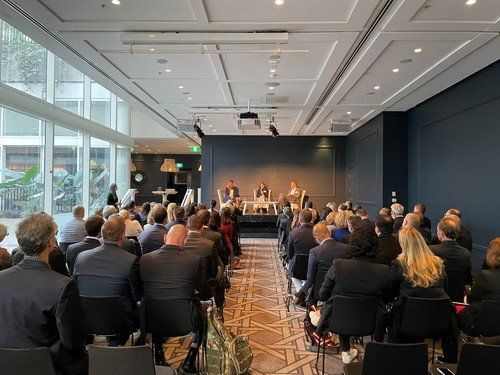News
The Pathway to the Boardroom is Not a Linear Journey

This week Derwent was delighted to welcome over 90 guests to our first ‘Pathway to the Boardroom’ breakfast since November 2019. Our guests commented:
‘The journeys the two Directors went through, their learnings and thoughts were fantastic. Both presenters gave the audience a deep insight into the planning you need to do in transitioning into Board life.’
`Great energy in the room, partly driven by the opportunity to network face to face again after such a long period of time.’

With the Covid crisis stifling risk appetite, it is refreshing to see a shift towards growth and innovation across the mandates we have been working on. As we heard from our speakers, Sue Klose and Peter Everingham, Covid has meant that boards have had to shift their mindset.
- Boards are now more comfortable with a faster decision-making process than they have in the past. Digital transformations that had been part of the 2-to-5-year strategic plan pushed to the forefront and executed in a matter of weeks/months.
- Significant focus on data strategy and cyber security.
- Key themes in relation to navigating through these times include agility, cross collaboration, and the ability to drive customer centric innovation.
- Sharper focus on customer engagement and simplification in the business was also strongly aligned with digital agenda.
- Importance of leadership, capability and the right structures. There are new challenges in building a collaborative and positive culture, hiring and onboarding staff.
- The wellbeing and mental health of staff is now a very important part of the boardroom discussion.
Our speakers’ insights were informative and authentic when discussing how their journeys to the boardroom had not necessarily followed a straight line. Some of the highlights from the discussion included:
- Know WHY you are doing this, reflect on your key drivers.
- Set realistic expectations and realise it is going to take time, this is a highly competitive space.
- Understand your END goal, it is important to know what to say NO to.
- Understand what your own Individual expertise are (‘Value Add’ to a board) i.e., customer focus / digital etc.
- You cannot be everything for everybody!
- Important to build out your network. Find NEDs that look like you, that have more experience, and can recommend you into opportunities.
- Be open to a range of opportunities, look outside just the ASX200.
Always take the ‘CALL’, the journey to the boardroom is not linear you never know where your next role may come from.

Share this article
Recent Articles



Sydney
Level 21
123 Pitt Street
Sydney NSW 2000
Australia
sydney@derwentsearch.com.au
Melbourne
Level 28
360 Collins Street
Melbourne VIC 3000
Australia
melbourne@derwentsearch.com.au
Perth
Level 29
1 Spring Street
Perth WA 6000
Australia
perth@derwentsearch.com.au
Brisbane
Level 19
10 Eagle Street Brisbane
Brisbane QLD 4000
Australia
brisbane@derwentsearch.com.au
Sydney
Level 21
123 Pitt Street
Sydney NSW 2000
Australia
+61 2 9223 1855
sydney@derwentsearch.com.au
sydney@derwentsearch.com.au
Melbourne
Level 11
350 Collins Street
Melbourne VIC 3000
Australia
+61 3 9691 1333
melbourne@derwentsearch.com.au
melbourne@derwentsearch.com.au
Perth
Level 15
240 St Georges Terrace
Perth WA 6000
Australia
+61 8 9282 5250
perth@derwentsearch.com.au
perth@derwentsearch.com.au
Canberra
The Realm
18 National Circuit
Barton ACT 2600
Australia
canberra@derwentsearch.com.au
Brisbane
Level 19
10 Eagle Street Brisbane
Brisbane QLD 4000
Australia
+61 2 9223 1855
brisbane@derwentsearch.com.au
canberra@derwentsearch.com.au
Canberra
The Realm
18 National Circuit
Barton ACT 2600
Australia
+61 2 9223 1855
canberra@derwentsearch.com.au
Derwent


